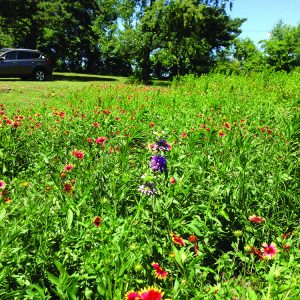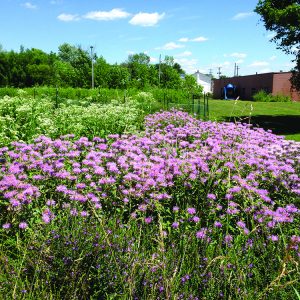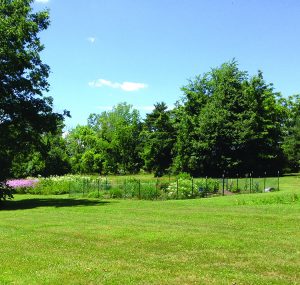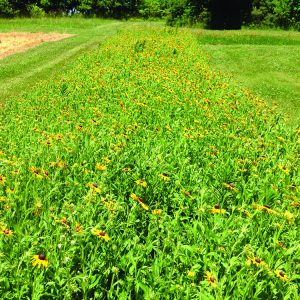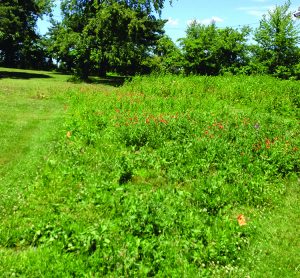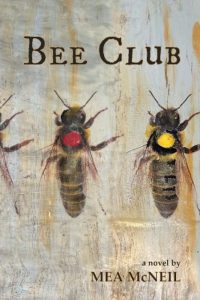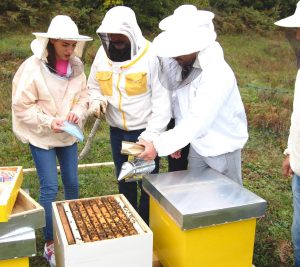By: Kim Flottum
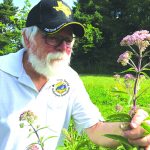 On the 10th of August we’re holding our second Pollinator Day here at the Root Company’s Pollinator Meadow, behind our Corporate Headquarters. There’s a several acre field back there that, for over a hundred years had sat idle, a playground for deer, rabbit, groundhogs and the occasional meadowlark. Then, a couple of years ago we started simple, with just a frost planting of a pollinator mix from Pennsylvania’s Ernst Seeds. That did so good that last year the local Medina County Master Gardeners wanted to join in with a phenology garden, part of a statewide program they have where they put the same flowering ornamental, landscape and pollinator plants several places in the state – running south to north – and record flowering dates at each location. They do a bang up job of taking care of the plot they have, mulching, fencing for those deer, groundhogs and rabbits, with even a bench to sit on and contemplate…phenology, I guess. It’s been working out quite well for them and they are good neighbors to have.
On the 10th of August we’re holding our second Pollinator Day here at the Root Company’s Pollinator Meadow, behind our Corporate Headquarters. There’s a several acre field back there that, for over a hundred years had sat idle, a playground for deer, rabbit, groundhogs and the occasional meadowlark. Then, a couple of years ago we started simple, with just a frost planting of a pollinator mix from Pennsylvania’s Ernst Seeds. That did so good that last year the local Medina County Master Gardeners wanted to join in with a phenology garden, part of a statewide program they have where they put the same flowering ornamental, landscape and pollinator plants several places in the state – running south to north – and record flowering dates at each location. They do a bang up job of taking care of the plot they have, mulching, fencing for those deer, groundhogs and rabbits, with even a bench to sit on and contemplate…phenology, I guess. It’s been working out quite well for them and they are good neighbors to have.
Also last year we cleared the way for another garden, this one sponsored by The Pollinator Partnership and their Monarch butterfly monitoring program. They got that planted and going great guns by bringing in a boatload of transplants. During last summer and this summer they come in on a schedule and count visiting adult Monarchs, other butterflies, and any larvae. They have these volunteer gardens all over the state and it’s a good project to be a part of.
The list of plants they use is striking. Zizia aurea (Golden Alexander), Liatris aspera (Blazing Star), Lyrthrum alatum (Winged Lythrum), Eupatorium purpureum (Sweet Joe-Pye-Weed), and Veronicastrum virginicum (Culver’s Root) is there. There are a few more species, but since they haven’t bloomed yet, I’m not sure what all will be coming back. Not all of these plants have come back at each site from last year, I’m told by Amber Barnes, the student who is running this for the group. Other species on the planting list that may come back are: Asclepias exaltata, Ascelpias incarnata, Asclepias tuberosa (three milkweed species), Echinacea purpurea (Purple Coneflower, a very popular pollinator plant). Then there’s Pycnanthemum virginianum (Mountain Mint), Solidago nemoralis, Solidago rigida, Solidago speciosa (three Goldenrod species), Symphotrichum laeve, and Symphotrichum novae-angliae (both Asters). And right now the wild bergamot, Monarda fistulosa, (wild bergamot) is in full purple display, as is Parthenium integrifolium, (Wild Quinine) a huge white-flowered umbel.
Then, this year they added two more plots to their plantings. They have a program where a couple of seed mixes are used to plant buffer strips alongside agriculture fields giving the beneficials a safe place to go before and after the crop blooms so there’s something there for them to eat and reproduce on so the population grows for next season. There’s an all wild flower mix and a legume/wildflower mix and we have one of each that’s just now (July 1) in full bloom. It’s a pretty impressive planting.
The Ohio State Beekeepers, working with the Pollinator Stewardship group have a plot up there too that we started this year. They have a seed mix from Ohio’s Ohio Prairie Nursery that is being used to establish larger plots on volunteered corporate and homeowner land. The land owners donate use of the land, now almost exclusively in turf, get the land prepared, and then, using seed from the Nursery paid for with grant money, lay out fairly large pollinator-friendly plots in urban and suburban settings that will last several years. It’s a good program and, yes, we’re glad we can help show it off.
This all goes back to five years ago when we placed some hives on the front lawn of what is now called the Homestead, the home A. I. Root built for his family next door to his new factory way back when. The hives were set almost next to the house, back from the street a bit, with the thought to encompass the whole rest of the front yard with bee plants. Although we ended up not using the whole yard, we put in a lot of those plants around and near the hives. At the same time we tore up the tree lawn in front of our main office building across the street from the Homestead and factory and put in a variety of bee friendly plants there, too. We’re located on a major traffic street in Medina and our flowers have gathered some attention in town. But it’s taken us a bit to find those plants that can tolerate some shade (there are, of all things, some Bradford pear trees planted on the tree lawn – more on them in a bit), and the salt spray from winter traffic. Each year we get a bit better at choosing replacements for those lost in Winter, and those that are thriving in that environment are multiplying – much like a Mother Nature Selected Queen, you could say.
The other thing we have to do is sit back and watch – the deer, the ground hogs, the gophers, the rabbits – who all want lunch in the middle of all this (not so much the street plantings, but those in the Meadow take a munching daily, or nightly, actually). We have to be able to say that, yes, these creatures will visit, but their visits won’t do the gardens in, but simply offer a bit of pruning when they get too tall. What worth would a roadside or agricultural field buffer planting have if you had to fence it, too? Fences certainly don’t keep out bees or butterflies, but the cost would be…well, any cost would be too much, let alone maintenance or replacement. So, these plants have to stand not only the test of local, the test of are they attractive to pollinators, but the test of all of nature’s hungry inhabitants. The Phenology garden is the exception to being eaten however. The Master Gardeners have to keep everything there in tip-top shape so they can compare apples to apples as it were, so a pretty solid fence keeps their garden safe from most of these floral predators.
We keep expanding each year, spreading from the tree lawn on the street to the green islands in the parking lots alongside our building, and some of the areas bordering the parking lots so the ‘floral look’ starts at the street and your gaze follows the flowers across the asphalt and up to the field behind our building, finally reaching those plots in the Pollinator Meadow.
This next year we’ll be expanding a bit more. We have plans to test some of the commercially available pollinator planting mixes sold in seed stores, farm outlets and the like to see how good they really are, or aren’t. So we’re getting the plots ready now for frost planting in December. We have a couple of acres left open, I think, so we’re not done yet, and we’re talking to Medina County Soil and Water who’s doing pollinator plantings, and we’re looking for more to test and try.
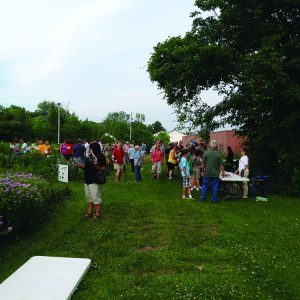
In June we invited The Medina Beekeepers, and anybody who wanted to, to come visit the gardens, and talk to reps from all of the garden sponsors.
Our input is minimal really. We prepare the plot area the previous fall, then plant after frost and it goes from there. We don’t have to weed, feed or manage…just water when it gets really dry (I spent a lot of years figuring out irrigation logistics on land a lot larger than this so it’s kind of fun doing that again). After all, these are all native plants, all wild and all Mother Nature Selected. Jeff, the guy who mows all this doesn’t mind at all because every time we put in a new garden there’s that much less he has to mow. But, there’s lots more corners and short pieces to mow so there’s more turning and jockeying around. But Jeff’s a pretty easy going fellow and it seems to work for him. Of course, there’s also that much more to feed the deer, groundhogs, rabbits and such too, so I’m not sure who comes out ahead.
I mentioned those Bradford Pear trees planted in the tree lawn, put in by the city of Medina Forestry Department a bunch of years ago. They are a popular street tree, but they’re not native, and, when first introduced, were supposed to be sterile and non-reproductive. Well, that changed somehow, and now they are just another pretty face, taking up space, spreading like wildfire and basically making a mess everywhere they are planted. The bloom is striking, which is why they were picked for showing off, but the blossoms actually have a fairly foul odor, not unlike all pear blossoms, so you’ll never see a bee on one of these trees. Plus, they are incredibly susceptible to disease and after only a few years the tips begin dying back, then whole branches, then the tops and finally the whole tree. A Bradford pear tree doesn’t belong in a pollinator garden, so we’re trying to convince the city to have them removed.
So on August 10th, we’ll have a day where all this is open to anybody that wants to come and visit. Everybody who’s part of this will be there to show off their gardens and programs. It runs from 11 to 4, the weather promises to be perfect and we’ll have representatives from all of the garden sponsors there to tell you more about their programs – folks from the Master Gardeners and The Ohio State University Pollinator Programs, the Monarch people, the Ohio State Beekeepers, Pollinator Partnership, Pollinator Stewardship, a few foodies will be there with honey ice cream, honey bakery items, honey popcorn (maybe), a couple of local CSA type farm folks with new-season apples and peaches for sale, Medina County Beekeepers and Medina County Soil and Water, seed companies selling pollinator seeds for gardens you can look at in bloom, and probably more. You’re invited. It’s free. There’s lots of parking and lots of people who want to share what they know about all this. Take a day, make the trip. It’ll be worth your time. Heck, it’ll be fun! We hope to see you there.
I visited the Collin County, Texas, beekeepers recently. They’re close to Dallas, and, to Josephine, where I got to spend an afternoon with John Talbert, who runs Sabine Creek Honey Farm. John and his crew, including his son John run about 800 colonies mostly for honey, but they send about 400 west to California for almond pollination, working with Denise Quayles and The Pollination Connection as their broker (we visited Denise a few years back when we did the Almond Odyssey). He works closely with Blake Shook, who you may have heard of, too. Sabine Creek sells about 600 nucs every year, and an ocean of honey, most of it retail. It’s a pretty neat operation and they seem to do a bang up job of just about everything they undertake. I’ll spend a lot more time with them next month, looking at management, harvesting, marketing and the rest, including the Texas State Fair, the Texas State Beekeeper’s Association and even some about Honey Queens. In the meantime, John shared one of his operation’s newest style hats with me. Thanks John. More in September.
We took some time over the 4th to catch up on yard and garden work neglected during the hectic month of June Travel. The garden is doing quite well for the first time in several years. The weather, the rain and the cardboard/straw mulch have all cooperated so you can count the weeds in there on one hand with fingers left over, and both the shallow and deep soil moisture are more than adequate. We cleared out the patch in front of the front porch so we actually have a porch you can see again, removing some decade’s old and severely overgrown shrubs and put in roses and, would you believe, a sourwood and tupelo tree. Sourwood is hardy to zone 5 most folks say, and I’m in 6 so it should be OK. It’s in a protected spot on the southwest corner of the house protected completely on the north and east side by house and garage and west side pretty much by a couple of evergreens. The Tupelo tree, planted a few feet away, is hardy to zone 4 so it should make it too, but neither of those trees are common this far north in Ohio. So I’ll wait a few years, and when they finally bloom, I can put on my honey label that this Ohio honey is infused with the two best honeys in the world – Sourwood and Tupelo.
But then, it takes a lot to beat locust honey. In my opinion, a real lot. Because of the work I did with Marina on the Honey Connoisseur I’ve spent a lot of time tasting a lot of honeys. I’m not as good as the guy from Sioux Bee who could tell the difference between North Dakota clover and Montana clover honeys, and not nearly as good as Marina who has been trained by the world’s best in Italy, but I think I can hold my own with most of the rest of ‘em when it comes to telling what honey is what, and what’s wrong with some of them. But what’s the best honey?
Well, if it’s still July when you are reading this, you may have a shot at finding out if yours is the best honey there is. The Good Food Awards entry window closes the end of July so maybe there’s still time to enter. You don’t have to send in any honey yet, but you have to enter by then. Go to www.goodfoodawards.org for the form, the rules, last year’s winners and more. They have a honey category and I’m on the committee that sets up the rules (no, I’m not a judge…I’m not that good yet). I hope to get to the finals this year in San Francisco just to watch. Maybe one day I’ll get to play with the big kids, but not yet. But you can…get entered. Get honey. Get going!
But that’s not what I started to say, though I’m glad it came out. What I started to discuss was honey. And actually, honey work. Most of us don’t do bees as a job though it often seems like it. No, most of us squeeze in honey work when daylight, weather, family, day job work, and the bees allow. So, like queens, mostly we do our bee work when we can, rather than when we want (most of us get the queens we can, not the queens we want, right?). That’s what happened over the 4th. The garden work, the deck-cleaning work, the mowing, the mulching all needed doing, but so did honey harvesting. We have a couple of young men come out once in a while to help with the heavy and hard parts of yard work, and they could be here only then, and not later, so you do that work when you can, and not so much when you want, and the honey harvest got pushed back and pushed back until the actual 4th.
Cool, cloudy, a stitch of rain just once in a while, windy, cool, cloudy . . . not bee weather by a long stretch. Not bee weather at all, actually, but all the boxes are full, no more to put on, honey coming in from white sweet, red and dutch clovers, but winding down and entering the usual July kind-of dearth we have every year, which gives us a window to do any mite treatments we need when honey isn’t on and none coming in, if you can get it off before it starts. It’s also the best time there is for making splits for mite control, and getting things ready for next year, and getting a chance to take care of the bees that take care of the bees that go into winter. If you can only get all that wonderful locust honey off, dang it.
Most years, well, some years when it works, our hives will have two supers of capped on right now, early July, the bottom super is spring…light, mild and wonderful. The top though is mostly locust, wonderful, wonderful locust. We often get it off before now…there’s been years when it came off on Memorial day no less, but most years it’s sometime in June, and sometimes early July, like this year.
What’s best is get the early spring off in May, the Locust off by mid-June and leave the early summer, all the clovers, tulip trees, catalpas, to cover the dearth so we don’t have to feed when there’s hardly anything coming in and still get two crops before the first of August – spring and locust. That’s what it used to be.
Anymore, that doesn’t work so much. Locust is later than it used to be, tulip is unpredictable as heck, clovers are all over the map and catalpas are sometimes, sometimes not. But the dearth is still there, but sometimes late, but lasting longer. And if you don’t get rain in early, early July, you don’t get goldenrod hardly at all in late August and September. But it’s early, early July that you get the dearth…Jeeze, what’s a beekeeper to do?
Well, the cool, cloudy weather is supposed to break and get warmer later this week…it is July after all…and since the 4th was a wash bee-wise, we went in to work on this issue, thinking that if indeed it did break, we’d take an afternoon and go get honey. Buzz is waiting to pick it up and get it extracted and I need the boxes for the fall flow that might or might not come…part of taking care of the bees is making sure there’s honey, more honey than they’ll need, way more. But they have to collect it first so I can leave it for later.
So, do we collect all that wonderful spring and locust honey and ‘hope’ there’s more later? Do we bet on the weather, the goldenrod and the rest of the fall crop? Or do we leave some on now in case there’s no more to come? I hate feeding bees. I really, really hate feeding bees. I’d much rather leave on a valuable crop of honey than have to feed late fall or early spring. And honey is so, so, so, so much better than sugar syrup for them. It’s a gamble. I’m not a gambler. No matter the weather this week or next, I think we’ll leave that extra, wonderful, wonderful super of spring honey for them…but I’ll take the locust. It’s a good trade. Have you ever tasted pure locust honey? If you have you know I’m right. If you haven’t, you still have much to learn about honey.
It’s August. Fall’s here. It’s time to take care of the bees that take care of the bees that go into winter. Keep your smoker lit, your hive tool handy and your veil tight. Enjoy the bees, and enjoy the life they give you.







